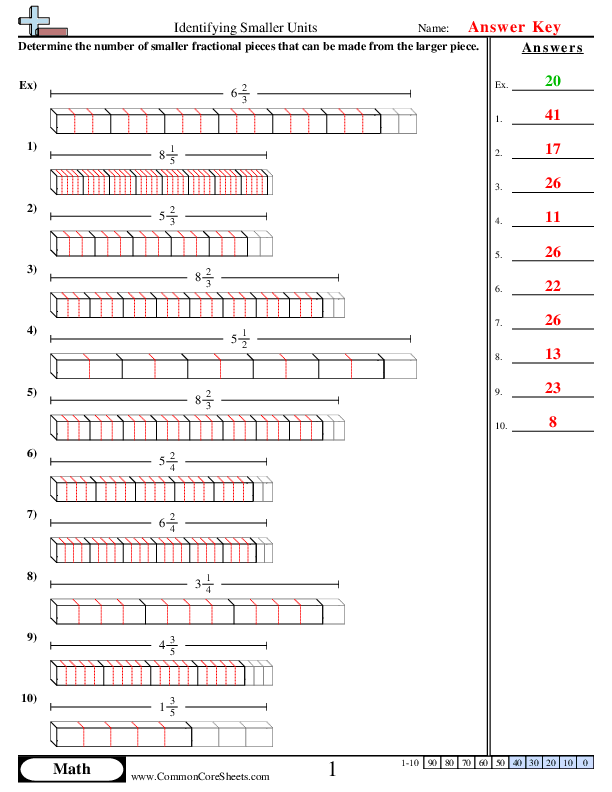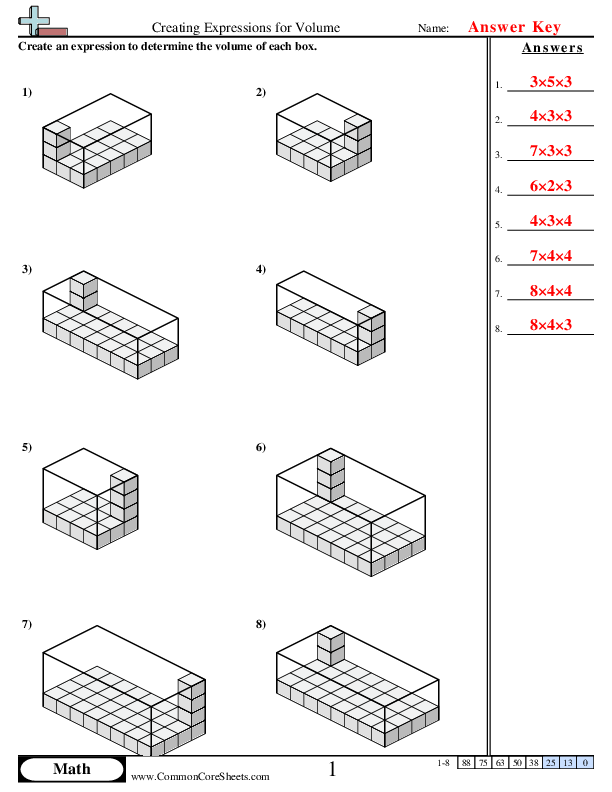Browse Sheets By Problem Type
×
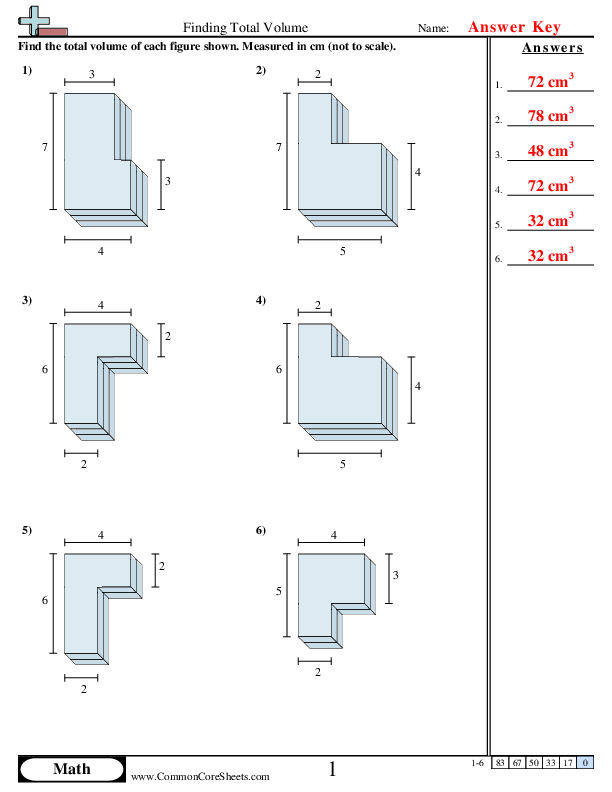
Finding Total Volume
5md5c


×
Description:
"This worksheet is designed to teach math learners the concept of finding total volume. It contains 6 carefully designed problems, with dimensions given for the length, width, and height. Users can customize the problems according to their learning level, convert them into flashcards for easy repetition, or use them for distance learning. An excellent resource to deepen understanding and boost mathematical skills."

×
Student Goals:
Enhanced Analytical SkillsAfter completing the worksheet, students will refine their analytical skills. They will learn how to dissect a problem and identify the required steps to reach a solution. Examining the problems in the worksheet aids in developing the students' abilities to decipher and employ problem-solving tactics effectively.Understanding of Volume ConceptsThe worksheet focusses on the concept of volume, which will afford students the ability to comprehend the principles of volume in mathematics. It will educate them on how the measurements of length, width, and height collectively inform the volume of an object. Grasping these concepts will enable them to tackle more complex volume-related problems in the future.Improved Mathematical FluencyWorking through the worksheet will improve the student's mathematical fluency. By frequently practicing with these problems, students can fine-tune their calculation skills. This recurring practice will foster a deeper understanding of mathematical operations and concepts, consequently boosting their mathematical performance and confidence.Enhanced Problem-Solving SkillsThe completion of this worksheet enables students to improve their problem-solving skills. Each problem can be considered as an investigation that students need to solve, which in turn, strengthens their ability to analyze and solve mathematical problems efficiently.Sequencing PracticeThis worksheet helps students practice effective sequencing. They are not only focused on finding the solution but also have to follow the correct sequence of steps to achieve it. This process assists in structuring their thought processes and enforcing logical reasoning, crucial skills for success in various life scenarios.Real-World ApplicationsOnce finished with the volume worksheet, students will understand how mathematical applications extend beyond the classroom. A robust understanding of volume can help students apply their learnings in a range of practical scenarios - whether it be to determine the amount a container can hold or to calculate space for storage purposes.


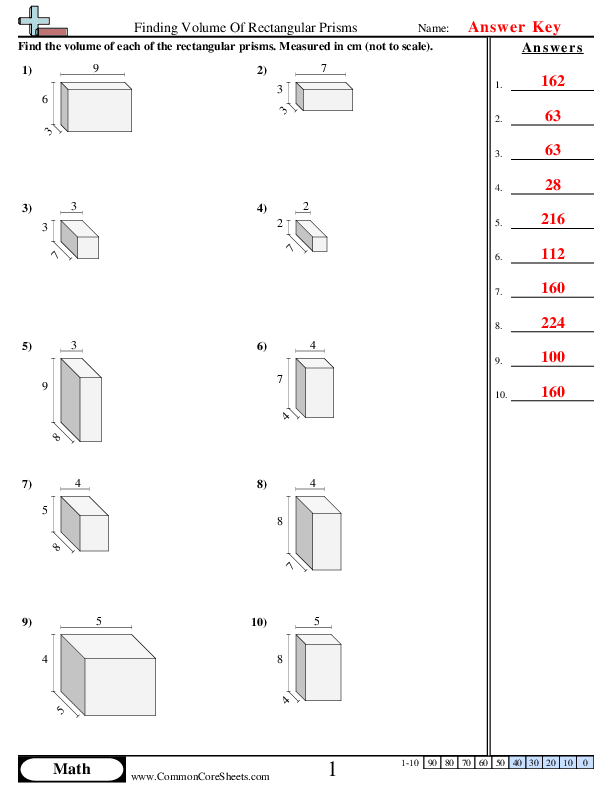
Finding Volume of Rectangular Prisms
5md5b


×
Description:
"This worksheet is designed to develop and strengthen children's knowledge in finding the volume of rectangular prisms in math. It includes 10 engaging problems that incorporate measurements in three dimensions - left-right, up-down, and angle. Versatile in nature, it can be personalized according to the student's skill level, transformed into interactive flashcards, or used effectively in distance learning environments."

×
Student Goals:
Mathematical Skill DevelopmentUpon completion of this worksheet, students should have improved in essential mathematical skills. Finding the volume of rectangular prisms is a fundamental concept that not only helps them grasp volume measurements but also assists in strengthening their three-dimensional spatial awareness. These tasks promote students' abilities to visualize dimensions, measure spaces and understand the interactions between length, width, and height.Critical Thinking and Problem-Solving SkillsThe worksheet is designed to encourage critical thinking and problem-solving abilities in learners. It presents various problems related to the calculation of volume, which requires learners to apply their knowledge and analytical skills. The process of identifying the correct method to calculate volume tests their comprehension and their ability to apply theoretical knowledge practically. This approach ensures that they can rely on their understanding of the subject matter, thereby boosting their confidence in tackling similar problems in the future.Application of GeometryAfter working through this worksheet, students will enhance their expertise in the practical application of geometry. In everyday life, they will be able to understand and relate to the various scenarios where knowledge of geometry, particularly volume calculation, is required. This acquaintance with perceptions of shapes, spaces, and quantities enables learners to make relevant connections to real-world contexts.Precision and AccuracyAs students progressively work their way through this worksheet, they get to practice the accuracy and precision of their calculations. Given the repetitive but varied nature of the tasks, pupils can understand better and rectify any mistakes, leading to more accurate results over time. This, in turn, improves their ability to deliver accurate answers more consistently.Mastery and ConfidenceLastly, successful completion of the worksheet will help students achieve a degree of mastery over the topic of finding volumes of rectangular prisms. Regular and prompt completion of the problems can result in a gradual boost of confidence, enabling students to approach math problems with a positive mindset. The more they practice, the more fluent they become in navigating these problems, supporting their overall mathematical proficiency.


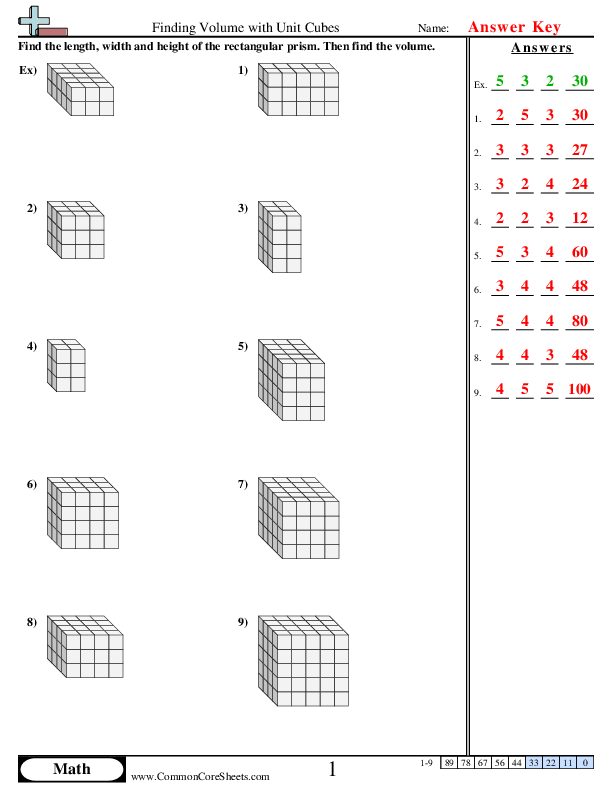
Finding Volume with Unit Cubes
5md4


×
Description:
"This worksheet is designed to help children grasp the concept of volume using unit cubes. It offers nine engaging problems to make learning interactive and enjoyable. The worksheet is easily customizable, allowing for use as flashcards or as a tool in distance learning environments. The aim is to simplify comprehension of mathematical volume and foster confidence in young learners."

×
Student Goals:
Understand the Concept of VolumeAfter completing this worksheet, students should have a foundational understanding of the concept of volume, a critical concept in geometry. They will grasp the principle that volume measures the space that an object occupies, typically in cubic units.Ability to Calculate Volume Using Unit CubesStudents will learn how to calculate the volume of various shapes using unit cubes. Through problem-solving, they will gain practical experience in determining the volume, enhancing their calculation skills and numerical comprehension.Develop Spatial ReasoningWorking with unit cubes to calculate volume will help students improve their spatial reasoning skills. They will learn to visualize shapes in three dimensions and understand the spatial relationships between these shapes.Improve Problem-Solving SkillsThe worksheet contains problems that challenge students to apply their understanding of volume and the use of unit cubes. This will not only test their comprehension but also enhance their problem-solving skills, which are crucial in math and other fields of study.Application in Real World ContextsThrough this worksheet, students will also get to understand how to apply the principles of volume in real-life situations. Understanding volume becomes relevant in a myriad of real-life applications such as figuring out how much a container can hold or how much space an object will occupy.Enhance Mathematical Language SkillsAfter completing this worksheet, students will be familiar with terms and concepts related to volume like unit cubes. This contributes to growing their mathematical vocabulary, facilitating their ability to communicate mathematically and enhancing overall math literacy.Confidence in Further Mathematical StudiesUltimately, the ability to understand and calculate volume builds a firm foundation for the student's further studies in more complex mathematical topics. This understanding thus builds their confidence in tackling other related mathematical topics in the future.


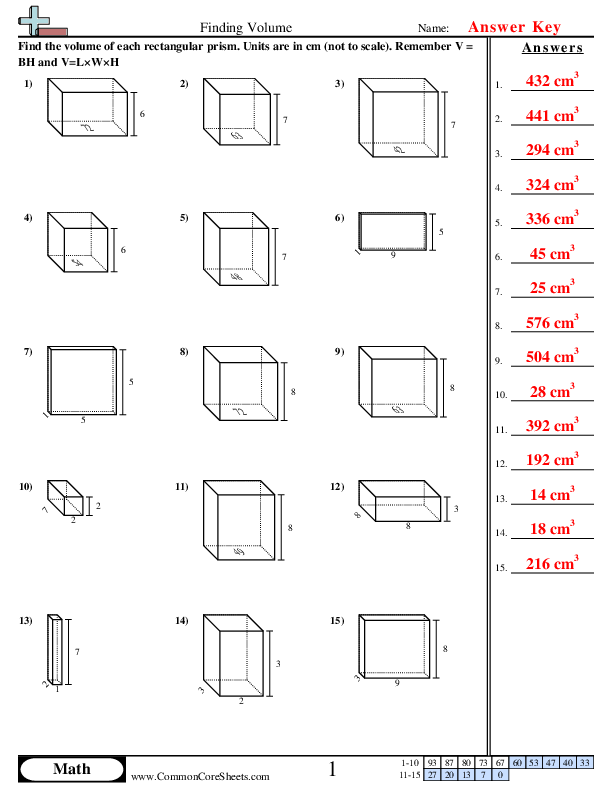
Finding Volume Transparent
6g2


×
Description:
"This worksheet is designed to help children understand and master finding volume in math. It contains 15 problems that involve calculating volume, providing real, practical examples. The worksheet is highly versatile and customizable, allowing the possibility of conversion into flashcards for enhanced memory training. It's also suitable for use in distance learning settings, serving as an excellent resource for educators and parents alike."

×
Student Goals:
Understanding of Volume ConceptsAfter completing the worksheet, students will have a solid understanding of volume concepts. They will have deep dived into what volume is and how it can be calculated. This is crucial in their mathematical journey as the concept of volume widely applies in different areas of study including geometry and physical science.Ability to Solve Volume ProblemsThe completion of the worksheet equips students with the necessary skills to independently solve volume problems. With a range of problems tackled in the task, they should be flexible and confident in solving volume-related questions. These problem-solving skills will be useful in their daily life where volume measurements are common.Enhanced Numerical SkillsBy working through the various volume problems, students will undoubtedly enhance their numerical skills. This includes both mental arithmetic skills and the ability to manipulate numbers. Such skills are foundational for other complex mathematical problem-solving requirements.Appreciation of Math in Daily LifeLastly, the worksheet helps to establish the connection between mathematics, particularly the concept of volume, and the real world. It helps in instilling a practical perspective in students' mind. By completing the task, they will fully comprehend that math is not just an abstract subject studied in school, but a vital part of everyday life.Improved Mathematical LanguageCompleting math worksheets also helps students to familiarize themselves with mathematical language and conventions, using them appropriately in various contexts. They will be able to demonstrate increased proficiency in mathematical communication, especially regarding volume measurements.


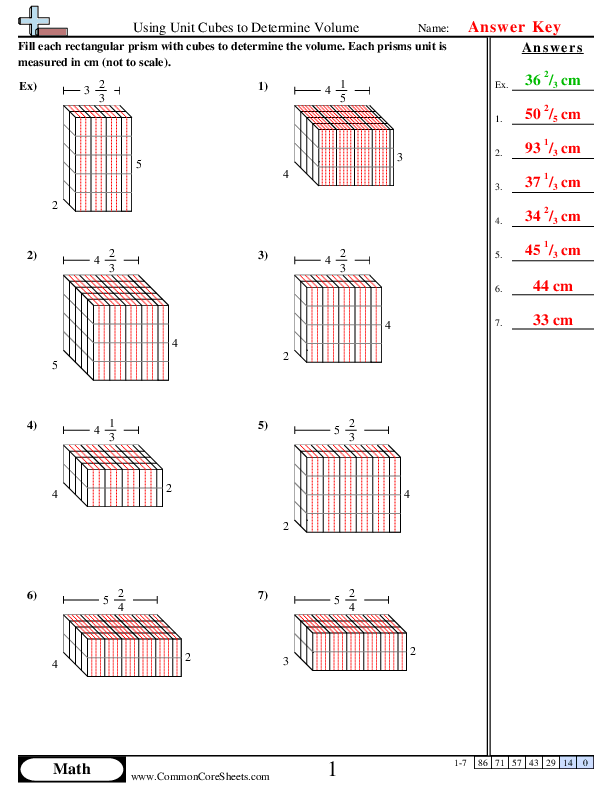
Using Cubes to Find Volume (Fractional Sides)
6g2


×
Description:
"This worksheet is designed to engage children in learning mathematics, specifically volume calculation using unit cubes. With seven unique problems, kids can unravel basic principles of geometry in an interactive way. The worksheet content is customizable, ideal for distance learning, and can also be converted into flash cards to enhance children's learning experience."

×
Student Goals:
Understanding of Volume ConceptsCompleting this worksheet would enable students to gain a solid understanding of the concept of volume. They would be able to define volume, recognize it as a measure of space occupied by a 3-dimensional object, and understand how it is measured in cubic units.Skill in Using Unit CubesThis worksheet is designed to inculcate in students the ability to use unit cubes to determine the volume of a structure. They learn to stack and count unit cubes, and to visualize 3-dimensional shapes constructed using these cubes. This ability is critical not only in understanding volume in math but is also an important spatial reasoning skill.Comprehension of Mathematical RepresentationsAn important goal of this worksheet is to enable students to decipher and interpret mathematical representations and diagrams. They would become proficient in discerning the dimensions of given structures with the help of such representations.Numeracy SkillsThese problems hone numeracy skills. Effective completion of the worksheet should boost students' abilities to perform basic mathematical operations and use these operations to work out the volume of various structures accurately.Problem-solving SkillsDetermining volume using unit cubes is a methodical process that requires careful counting and calculating. It demands keen attention to detail and systematic working. By resolving these worksheet problems, students gradually build sound problem-solving skills, which are a vital aspect of an individual’s cognitive development and are essential across various life scenarios.Application AbilitiesLastly, after doing the worksheet, students should be able to apply their knowledge of volume to find the volume of other similar structures beyond the classroom. This application ability is central to the principle of mathematics and empowers students to engage with their spatial environment more effectively.


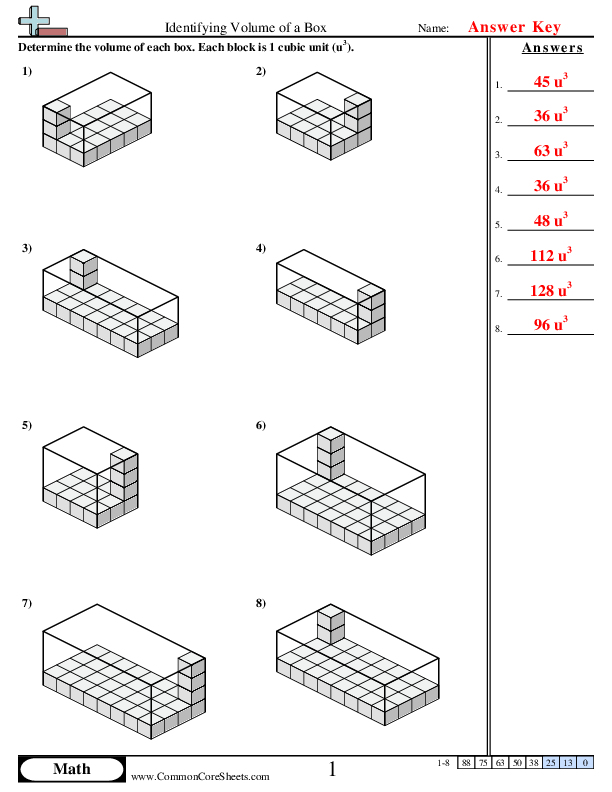
Identifying Volume of a Box
5md3b


×
Description:
"This worksheet is designed to enhance children's understanding of the fundamental math concept, the volume of a box. With eight unique problems, kids are challenged to identify volumes in a fun and interactive way. Its flexible format can be customized for individual learning, converted into flashcards for engaging revision sessions, or seamlessly integrated into distance learning platforms. A great resource for fostering math proficiency in young learners."

×
Student Goals:
Mathematics proficiencyStudents should have the ability to efficiently calculate and comprehend the concept of volume, especially pertaining to real-world objects like a box. They should be able to distinguish volume from other spatial attributes like surface area and length, and understand where and why it is applied.Problem-solving skillsThis worksheet aids in developing problem-solving skills as the students must deduce the correct method for calculating volume and apply it to solve the problems. The skill of determining the best approach to a problem is not only a critical part of mastering mathematics, but it is also highly beneficial in everyday life.Reinforcing knowledge of geometrical shapesBy identifying the volume of a box, students will reinforce their understanding of geometrical shapes and their properties. Through practice, they will gain a deeper understanding of how changing one attribute of a shape (i.e., length, width, or height) can drastically change the volume.Logical ThinkingAfter successfully completing this worksheet, students should have improved their ability to think logically and analytically. Mathematical problems require a certain level of analysis involving several steps or calculations. Developing these skills is essential for the complex problem-solving that future math courses will require.Application of mathematical conceptsA mastery of this worksheet will give students an extra tool in their mathematical toolbox: the ability to calculate volume. With this skill, they will be able to use and apply this mathematical concept in various contexts, whether in further mathematical studies, sciences, or even practical everyday situation.Building ConfidenceWith each correct answer, students gradually build their confidence in managing math problems. This worksheet, when completed, could provide a significant boost to their self-assuredness in handling more complex mathematical tasks in the future.


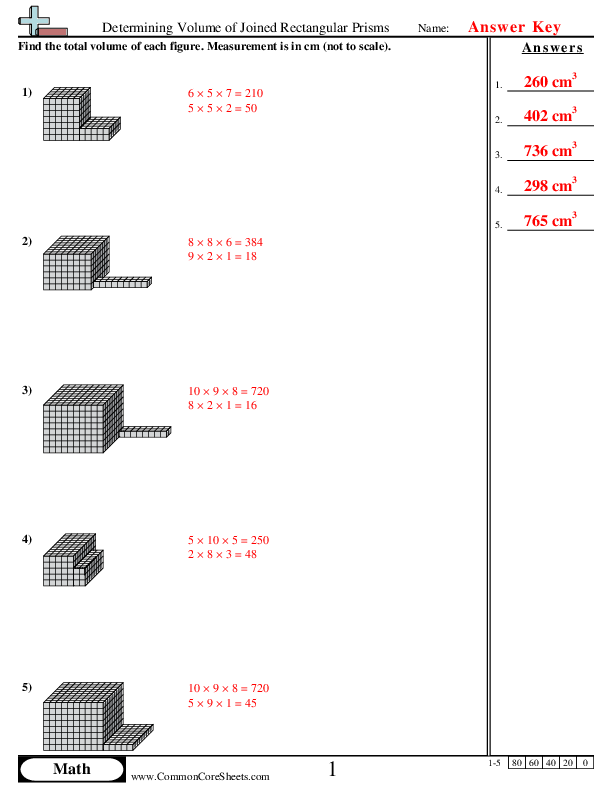
Determining Volume of Joined Rectangular Prisms


×
Description:
"This worksheet is designed to enhance children's understanding of calculating the volume of joined rectangular prisms. It includes five interactive math problems, illustrating the concept with real-world examples. The worksheet can be customized according to individual learning needs, converted into flashcards for quick revision, and is perfectly suited for distance learning environments."

×
Student Goals:
Understanding the ConceptAfter completing the worksheet, students will have a solid understanding of the principles of calculating the volume of joined rectangular prisms. They will grasp basic multiplication and will likely find it more intuitive moving forward with complex geometrical problems.Applying the FormulaOnce this worksheet is completed, learners will be able to apply the formula for determining the volume of rectangular prisms and joined rectangular prisms without hesitation. The formula includes both basic and complex scenarios, further forging their mathematical confidence.Problem-solving SkillsThe worksheet aims to enhance the students' problem-solving skills. The problems set in the worksheet are logically arranged, requiring them to follow steps and use their critical thinking ability to arrive at the correct answers.Handling ComplexityAs the complexity of the problems increases gradually, students will develop resilience and the skill to handle complex mathematical problems. It will prepare them for encountering similar scenarios, not just in the area of calculating volume but also in other mathematical concepts.Confidence BuildingThe repetitive and tiered structure of the problems helps to cement knowledge and builds confidence. By the end of this worksheet, they will have mastered the topic to the extent that they will have confidence in explaining the concept to their peers.Practical ImplementationAfter completing the worksheet, students will be able to effectively apply the concept in solving real-world problems. They’ll be able to understand the practical implications of calculating volume in various fields like engineering, architecture, and more.Knowledge ReinforcementBy practicing the problems in the worksheet, the students' knowledge about the concept of volumes will be reinforced. Continuous practice will ensure that the acquired knowledge becomes a part of their long-term memory, making it easier to recall in the future.


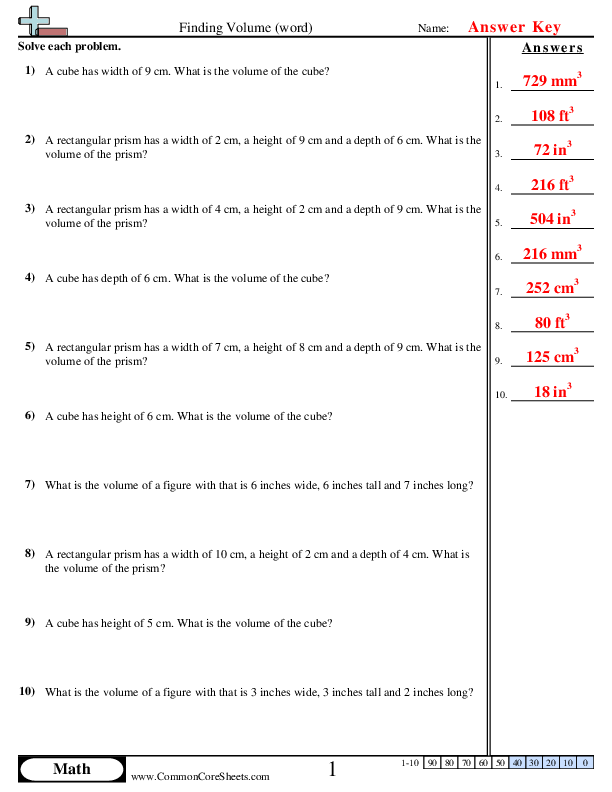
Finding Volume (word)


×
Description:
"This worksheet is designed to improve children's knowledge of finding volume in mathematics. It consists of 10 problems involving the calculation of volume for prisms and cubes and can be customized for difficulty levels. With versatility for use in distance learning environments, these problems can also be converted to flashcards for an engaging, hands-on experience for learners."

×
Student Goals:
Understanding Volume ConceptsAfter completing the worksheet, students should have a clear understanding of volume as a three-dimensional measure of space. Through the application of both cube and rectangular prism volume formulas, students will grasp the concept fundamentally, learning how to apply it to different real-world shapes. They would understand the relationship between the length, width, and height of a shape and its volume.Problem-Solving SkillsThe students should develop the ability to solve various volume problems effectively. The wide range of questions in this worksheet ensures that the students can tackle problems that require different problem-solving skills, which can extend to other math topics and real-life scenarios. They would also improve their comprehension of word problems and their translation into mathematical terms.Application of Mathematical FormulasStudents would be proficient in using specific mathematical formulas such as those for finding the volume of a cube and a rectangular prism. This proficiency includes substituting correct values into these formulas to solve real-world and mathematical problems. Students will learn to use these equations to solve for unknown values, facilitating mathematical thinking.Units of MeasurementBy practicing a range of volume problems in different units (cm, inches), students will improve their proficiency in measurements, including the conversion from one unit to another. They would understand the practical importance of units and the necessity of correctly using and interpreting them.Enhanced Mathematical VocabularyUpon completion, students will be able to verbalize mathematical observations and findings accurately. They would solidify their understanding of key terms related to volume, such as depth, width, and height. When describing the process or the solution, they would be able to use the appropriate terminology, enhancing their mathematical vocabulary.Real-world Applications of MathematicsBy figuring out the volume of various shapes, students will realize the relevance of what they've learned to their everyday lives. They would appreciate how volume calculations can be beneficial in numerous real-world situations such as packaging, construction, and many more. This practical outlook could further motivate them to engage with and understand mathematical concepts.


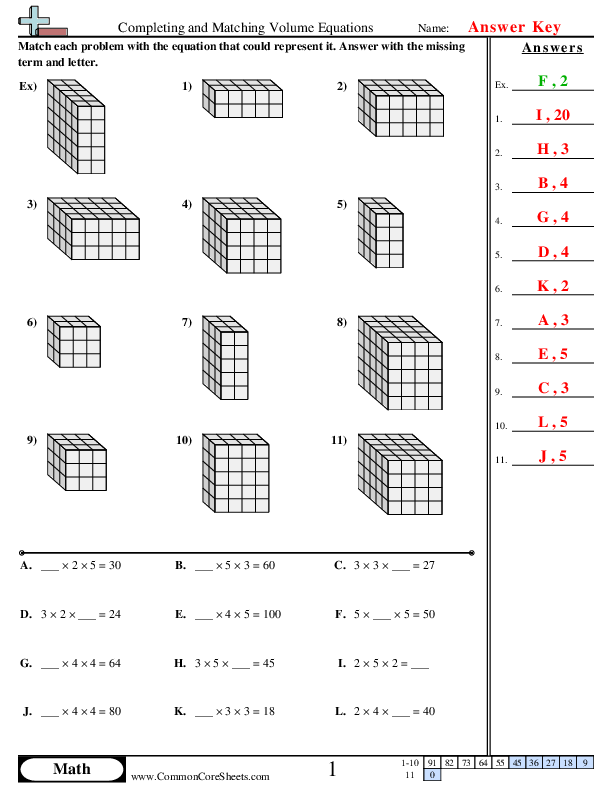
Completing and Matching Volume Equations


×
Description:
"This worksheet is designed to strengthen children's math skills, focusing specifically on volume equations. It features 11 unique problems that require learners to complete and match volume equations. It's an adaptable tool perfect for individual exercise or distance learning. Customizable to cater to varying skill levels, it can even be converted into flashcards - making learning engaging and versatile."

×
Student Goals:
Understanding Volume EquationsAfter completing this worksheet, students should have a deepened understanding of volume equations. They will become proficient in identifying and matching various volume equations, learning how to classify and fit them correctly. This is no small task, as it requires familiarity with different aspects of volume equations and the ability to distinguish between them according to their characteristics.Problem-Solving SkillsStudents will develop proficient problem-solving skills through the process of completing and matching volume equations. In figuring out how different equations pair up, students are required to analyse, reason, and apply their mathematical knowledge. This deliberate practice will allow them to perfect these vital problem-solving skills, which are applicable in many other areas of learning.Practice Mathematical LiteracyThis worksheet enables students to practice their mathematical literacy skills. It encourages them to understand mathematical terminology, symbols, and notations relating to volume, which are fundamental math literacy skills. Image-to-text correlation is another literacy skill that they could acquire, as they connect mathematical equations to matching volume representations.Boost Critical ThinkingCritical thinking skills are enhanced as students complete and match volume equations. They will need to understand the fundamentals of the equations before they can effectively match them. This practice encourages students to think critically about the components that constitute each equation and how these components can vary in different circumstances.Enhance Memory RecallCompleting this worksheet can help improve students' memory recall by enforcing repetitive learning. With a number of problems to solve, students are continuously exposed to similar volume equations. This improves their memory of learnt concepts, as they repeat and reinforce these ideas.Independent LearningLastly, the worksheet acts as an effective tool for independent learning and self-evaluation. Upon completion, it gives students an insight into their understanding of the subject matter and identifies areas they need to improve on. It encourages an active role in learning, thus fostering resilience, determination, and confidence in their mathematical abilities. This independent exposure builds a strong foundation for future mathematical challenges and tasks.






